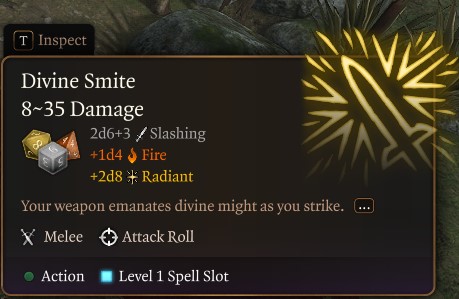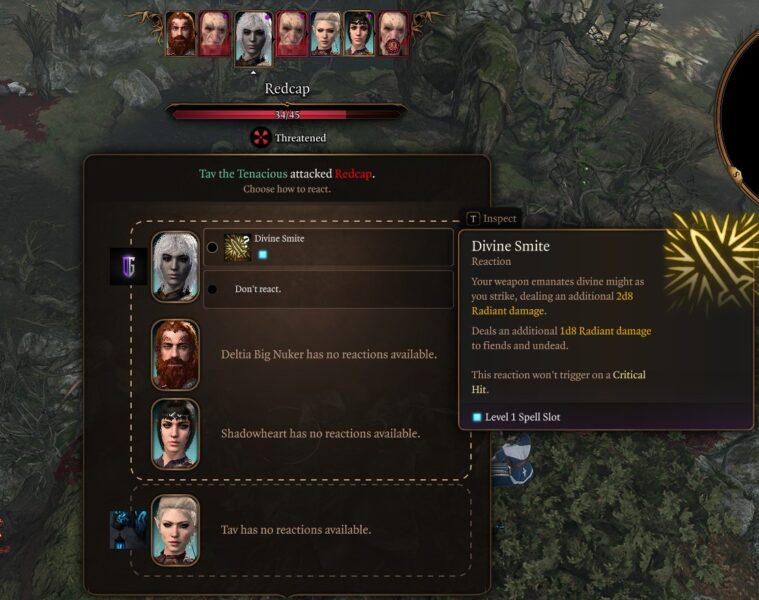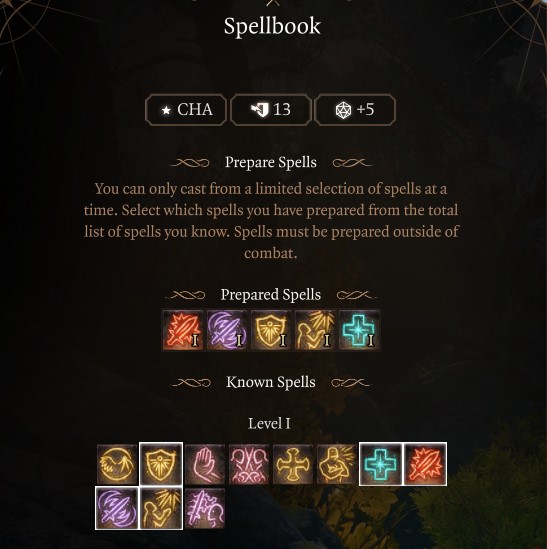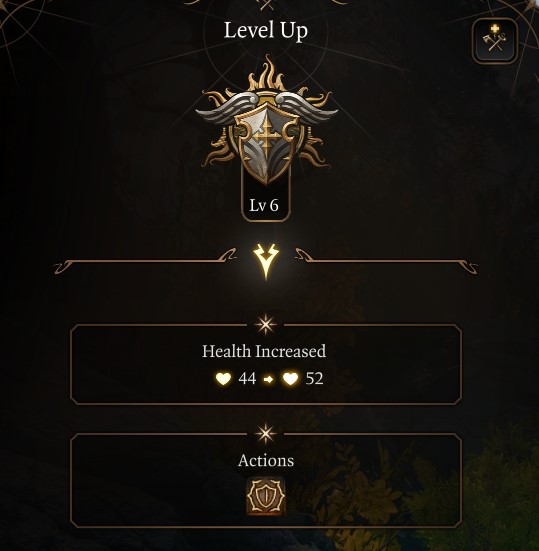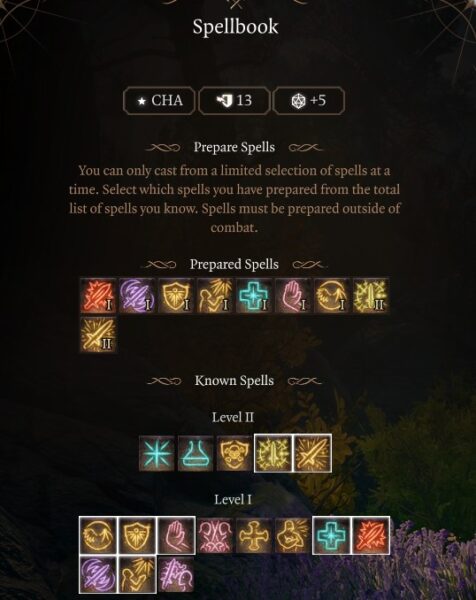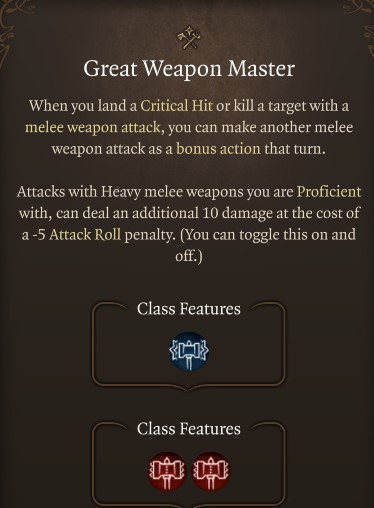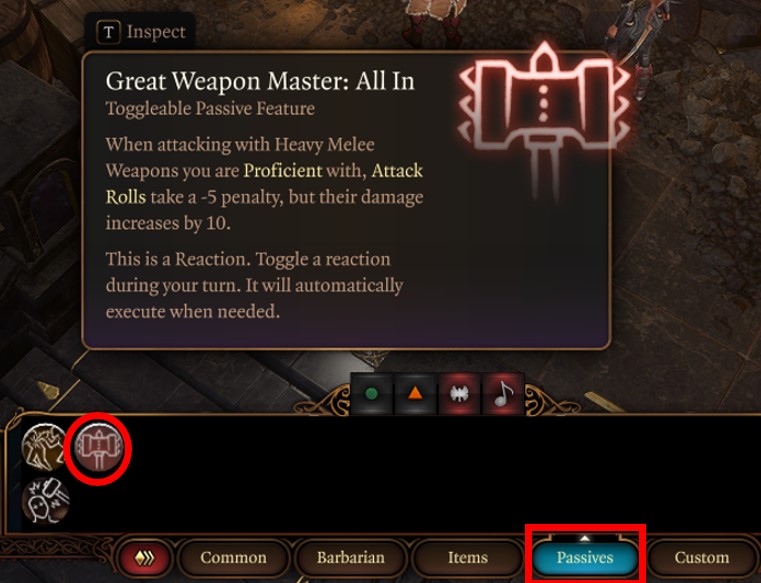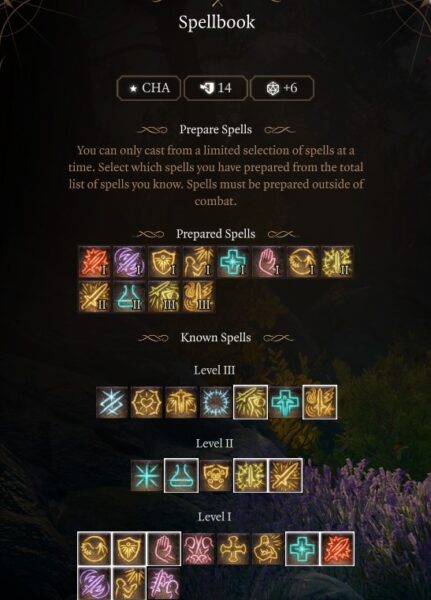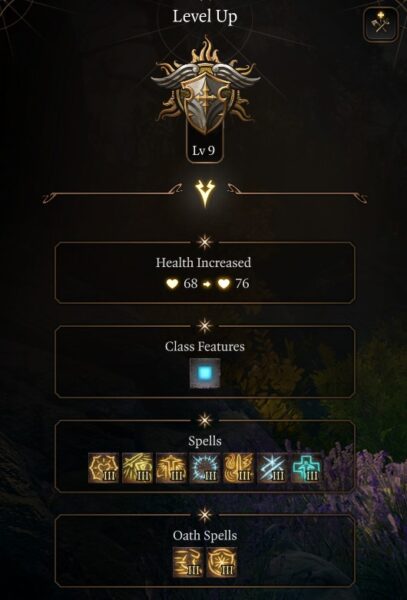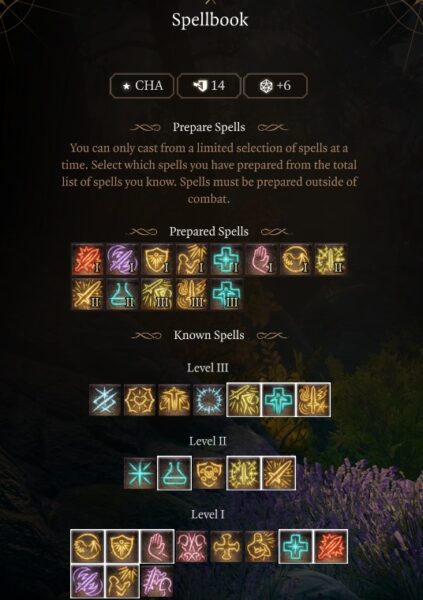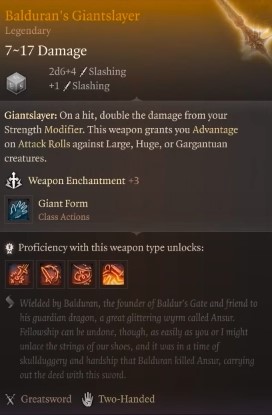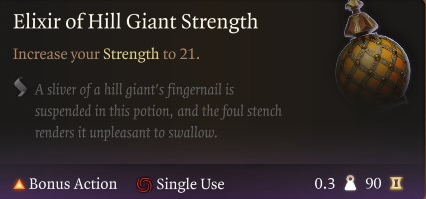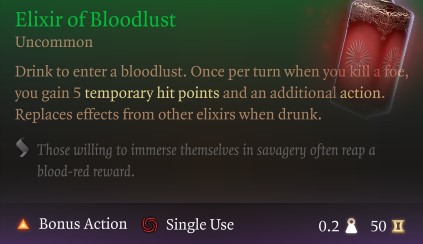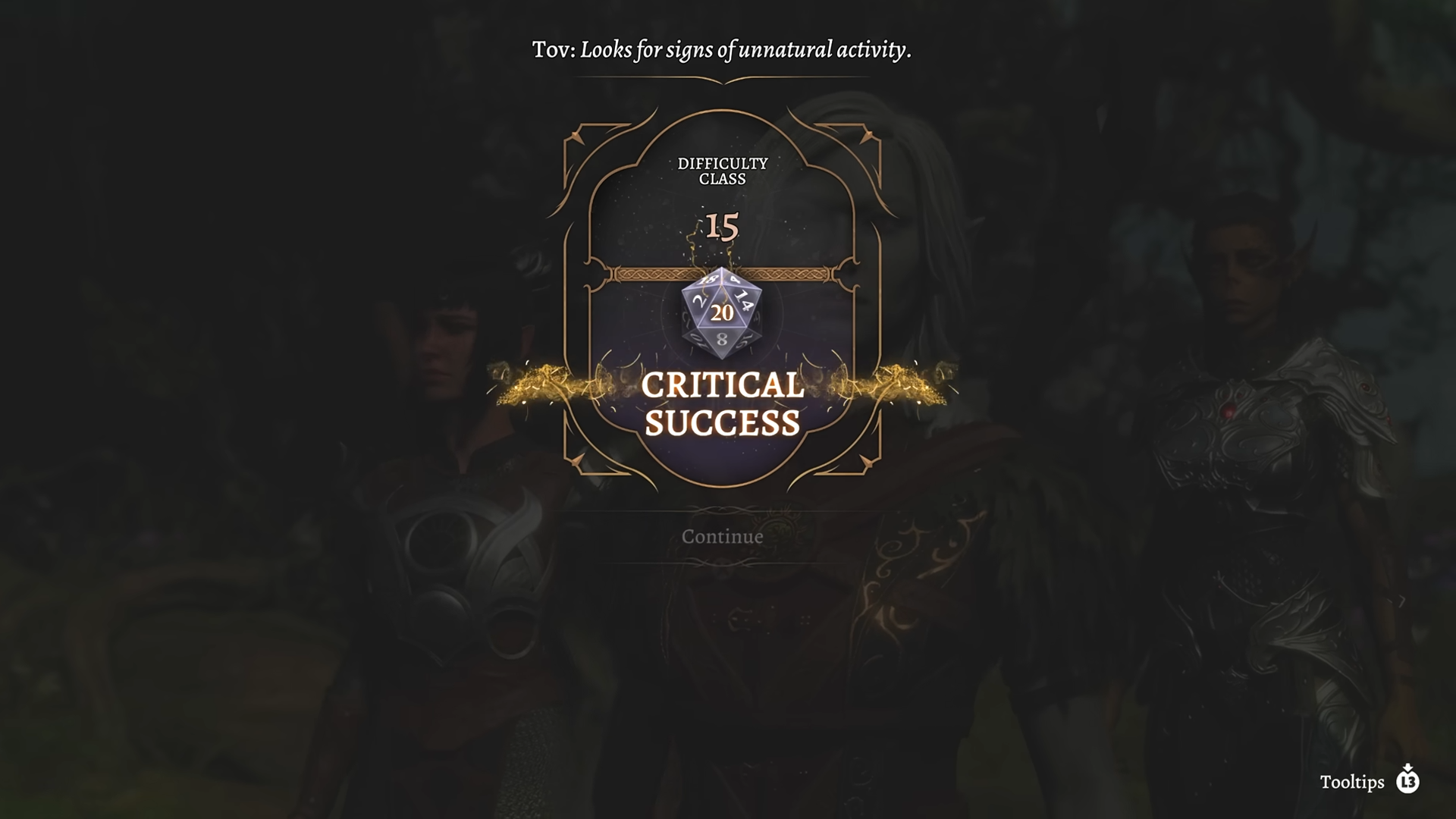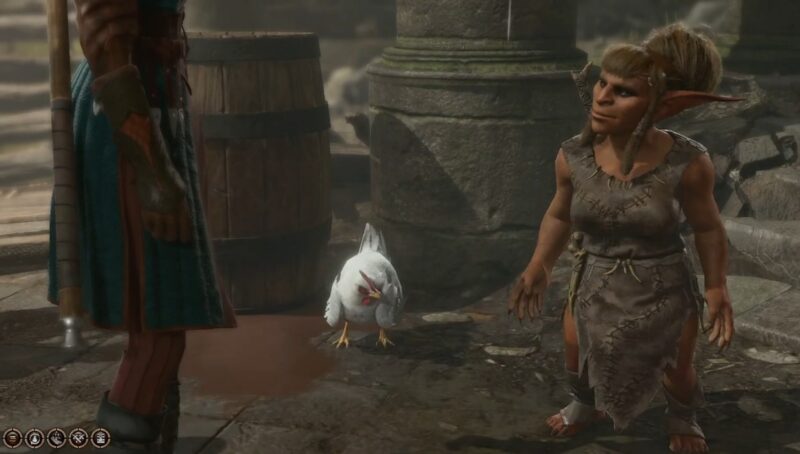This guide focuses on the best Paladin build in Baldur’s Gate 3, the Oath of Vengeance subclass, and includes all components to build a powerful character.

This build page has been updated for the Patch 8 version of Baldur’s Gate 3.
Related Video:
Everything About The Vengeance Paladin
In Baldur’s Gate 3, the Oath of Vengeance Paladin focuses on hunting down and punishing those who have done wrong. What makes Paladin unique is their Divine Smite ability, Charisma, weapon and armor proficiency, and incredible combat power. Moreover, the Paladin excels at influencing dialogue and aiding the party in non-combat situations. With the Paladin, you blend the best of both worlds in BG3, great combat performance with utility in dialogue and exploration.
The downside to the Paladin is limited spell slots and weak mobility at the start. So, expect a slow start, with a complex series of spells. Most of the spells you can ignore and just Divine Smite blast every enemy in your way.
For this build, we will use the the Vengeance subclass. Vengeance has high mobility with access to the Misty Step spell at level 5. This gives it an enormous advantage when the Paladin’s movement is weaker at the start of the game. Your subclass offers powerful spells at various levels that are always prepared. Consider the Vengeance a great subclass for the Paladin if you don’t want to break your Oath.
| Pros of Paladin Build | Cons of Paladin Build |
|---|---|
| Crowd Control | Spell Slot Starved |
| High Burst Damage | Limited Spells |
| Heavy Armour | Complex |
Oath of Vengeance Paladin Changes in Patch 8
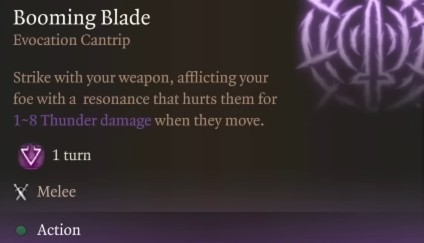
The biggest changes to the Oath of Vengeance Paladin build in Patch 8 of Baldur’s Gate 3 come from the addition of new subclasses, spells, and cantrips. The overall flow of combat remains largely the same, but with new subclasses come powerful new multiclassing opportunities.
Moveover, the Booming Blade cantrip now offers a better advantage by adding thunder damage to each attack, making it a strong option. Especially when multiclassing into Hexblade Warlock, Sorcerer, or Wizard, or by selecting it with the High Elf’s bonus cantrip. While the Half-Orc race remains the top pick for pure melee damage, Booming Blade adds versatility and burst potential to hybrid builds.
Related:
Paladin Class Features & Mechanics

The following list presents all the essential Oath of Vengeance Paladin Class Mechanics and Features in Baldur’s Gate 3:
- Primary Ability: Charisma
- Saving Throw: Wisdom and Charisma
- Subclass: Oath of Vengeance
- Armor Proficiency: Light Armour, Medium Armour, Heavy Armor, Shields
- Weapon Proficiency: Simple Weapons, Martial Weapons
- Preferred Weapon: Two-hand Greatsword
- Preferred Armor: Heavy Armour
- Channeled Oath Charges: Paladin-specific resource that allows the casting of spells and abilities.
- Divine Smite: Expend spell slots to deal additional radiant damage on a successful melee attack.
- Inquisitor’s Might: You or an ally’s weapon attacks deal additional Radiant damage equal to your charisma modifier.
- Abjure Enemy: Frighten an enemy, Fiends and undead have Disadvantage on this Saving Throw.
- Vow of Enmity: Gain Advantage on Attack Rolls against an enemy.
Paladin Spell Mechanics
- Cantrips: are like spells, but you can cast them infinitely, and they don’t take your spell slots.
- Spell Slots: will use your spell slots, which are a limited resource during combat and will require a long rest in order to refill.
- Prepared Spells: a Paladin mechanic that allows you to swap in and out spells prior to combat.
- Concentration: is a spell mechanic in Baldur’s Gate 3 that some Spells require to maintain and keep their magic active.
Paladin spell casting in general, is limited compared to other classes and builds. But the Divine Smite additional damage mechanic consuming spell slots is the real reason you can do an amazing amount of damage. In general, save the spell slots for this usage unless you need a buff, heal, or crowd control.
Paladin Class and Best Subclasses
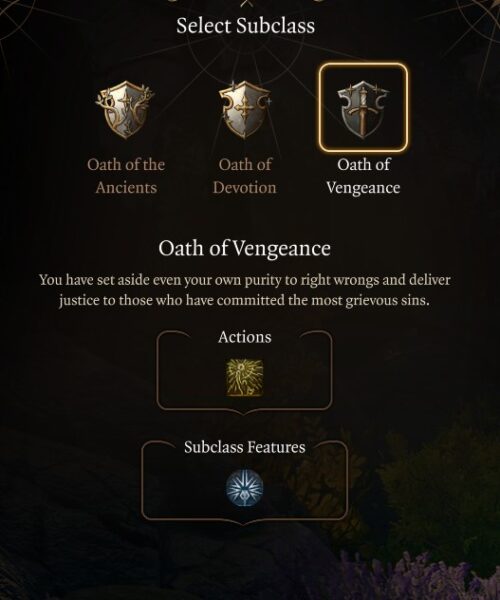
The Oath of Vengeance subclass is a great Paladin subclass in Baldur’s Gate 3 because it offers powerful damage abilities, debuffs, and high survivability. You can unlock your subclass right away as a Paladin in the character creation screen.
Here are all the Baldur’s Gate 3 Paladin subclasses:
- Oathbreaker: damage-focused, crowd control, and control undead.
- Oath of the Ancients: nature-based spell-focused, natural world Paladin.
- Oath of Devotion: healing focused, radiant damage, “good” Paladin.
- Oath of Vengeance: Seeks revenge and extra damage when tracking down enemies. Available on the full launch
Baldur’s Gate 3 Oath of Vengeance Paladin Features & Progression
The Oath of Vengeance subclass unlocks the following features and spells:
- Oath of Vengeance Tenets (Level 1): Oath of Vengeance Paladins abide by the following tenets: Fight the Greater Evil. Exerting your wisdom, identify the higher morality in any given instance, and fight for it. No Mercy for the Wicked. Chasten those who dole out their villainy by wiping their blight from the world forever.
- Inquisitor’s Might (Level 1): You or an ally’s weapon attacks deal additional Radiant damage equal to your charisma modifier (minimum of 1) and can Daze enemies for 2 turns.
- Abjure Enemy (learned at level 3): Frighten an enemy. They’ll be easier to hit and cannot move. Fiends and undead have Disadvantage on this Saving Throw.
- Vow of Enmity: Gain Advantage on Attack Rolls against an enemy.
- Oath Spells: Band and Hunter’s Mark
- Oath Spells (Level 5): Misty Step and Hold Person
- Relentless Avenger (learned at Level 7): If you hit an enemy with an Opportunity Attack, gain 4.5m movement next turn.
- Oath Spells (Level 9): Haste and Protection from Energy
Paladin Divine Smite Explained
Divine Smite is a signature ability of the Paladin class in Baldur’s Gate 3. It allows a Paladin to expend a spell slot to deal additional radiant damage to a creature they have hit with a melee weapon attack. The amount of extra damage is equal to 2d8 for a 1st-level spell slot, plus 1d8 for each spell level higher than 1st. The damage increases by 1d8 if the target is an undead or a fiend.
Divine Smite can be toggled on or off in the reactions menu under the user interface. This allows you to make a decision if you want to use it or not. This is very important because the Paladin can run out of Spell Slots quickly, limiting damage. The last thing you want is to expend a spell slot needlessly on a weak creature.
Here are some tips for getting the Best Paladin Build to use Divine Smite effectively in Baldur’s Gate 3:
- Save your higher-level spell slots for tougher enemies.
- Use Divine Smite against enemies that are vulnerable to radiant damage.
- Consider using Divine Smite on a critical hit, as this will maximize the amount of damage you deal.
- Don’t be afraid to use Divine Smite multiple times per turn, especially if you are facing a group of enemies.
Related:
Character Creation for Paladin Oath of Vengeance Build
| Category | Selection |
|---|---|
| Character | Origin – Custom character |
| Race | Half-Orc |
| Racial Bonus | Relentless Endurance, Darkvision, Savage Attack |
| Class | Paladin |
| Subclass | Oath of Vengeance |
| Spells | Searing Smite, Thunderous Smite, Shield of Faith, Divine Favour, Cure Wounds |
| Background | Soldier |
| Ability Score | STR: 16 DEX: 10 CON: 14 INT: 8 WIS: 10 CHA: 16 |
| Skill Proficiencies | Persuasion and Insight |
Recommended Backgrounds

Soldier is the Best Background for the Best Paladin Build in Baldur’s Gate 3 because you gain proficiency in Athletics and Intimidation. Athletics scales with Strength while Intimidation scales with Charisma ability score thus they will help you both in combat situations and while exploring. This choice mostly influences roleplaying and dialogue options aspects and allows you to create unique characters. Here’s a list of the best backgrounds for the Best Baldur’s Gate 3 Paladin Oath of Vengeance Build Guide:
- Soldier: Proficiency in Athletics and Intimidation. You are trained in battlefield tactics and combat, having served in a militia, mercenary company, or officer corps. Soldier companions in BG3 are Jaheira and Lae’zel.
- Noble: Proficiency in History and Persuasion. You were raised in a family among the social elite, accustomed to power and privilege. A noble companion is Minthara.
- Guild Artisan: Proficiency in Insight and Persuasion. Your skill in a particular craft has earned you membership in a mercantile guild, offering privileges and protection while engaging in your art. No Guild Artisan companions in BG3.
Best Race Choice Paladin Build
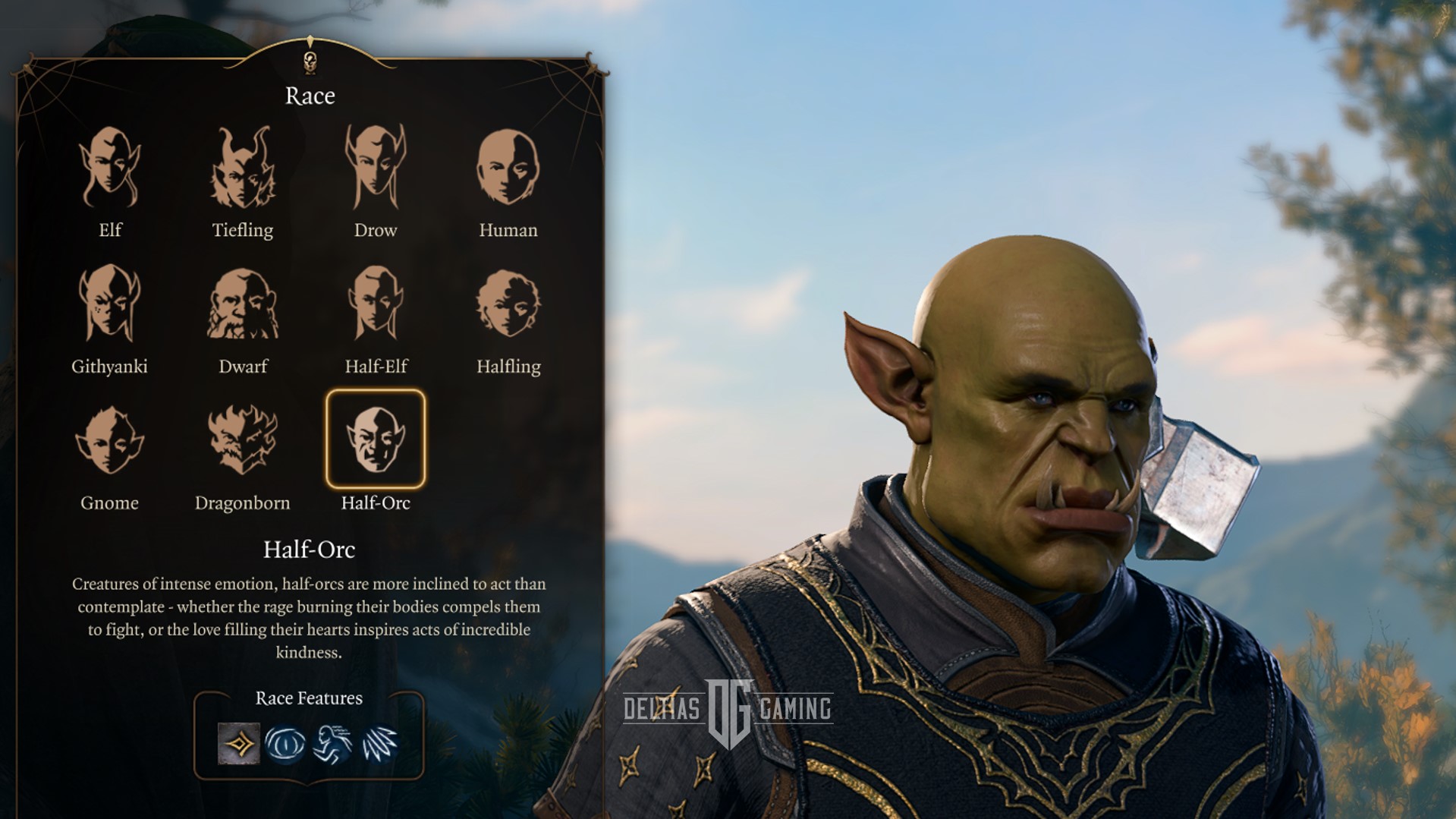
The Half-Orc is the best race choice for Oath of Vengeance Paladin in Baldur’s Gate 3 because the Relentless Endurance racial feature can save you from death dropping to 0 hit points you stay at 1 for a turn. The Half-Orc’s savage attack allows for extra damage and Darkvision is vital playing in the Underdark. A secondary choice is Zariel Tiefling because of fire resistance and two free smite spells, Searing and Branding.
Here’s the best Race choice for a Paladin Build:
| Half-Orc | Zariel Tiefling |
|---|---|
| Relentless Endurance | Hellish Resistance |
| Menacing | Searing Smite |
| Darkvision (12m) | Darkvision |
| Savage Attack | Branding Smite |
The Paladin’s racial choice will not influence ability score, but everyone should get a +2 and +1 to spend regardless. This frees your race choice up to not completely hinder yourself based on ability score, but race features. Each of these races offers unique advantages that can enhance your combat prowess, survivability, or utility. Additionally, consider the roleplaying opportunities and character concepts that resonate with you for the Best Baldur’s Gate 3 Paladin Oath of Vengeance Build Guide.
Recommended Skills for Paladin Oath of Vengeance
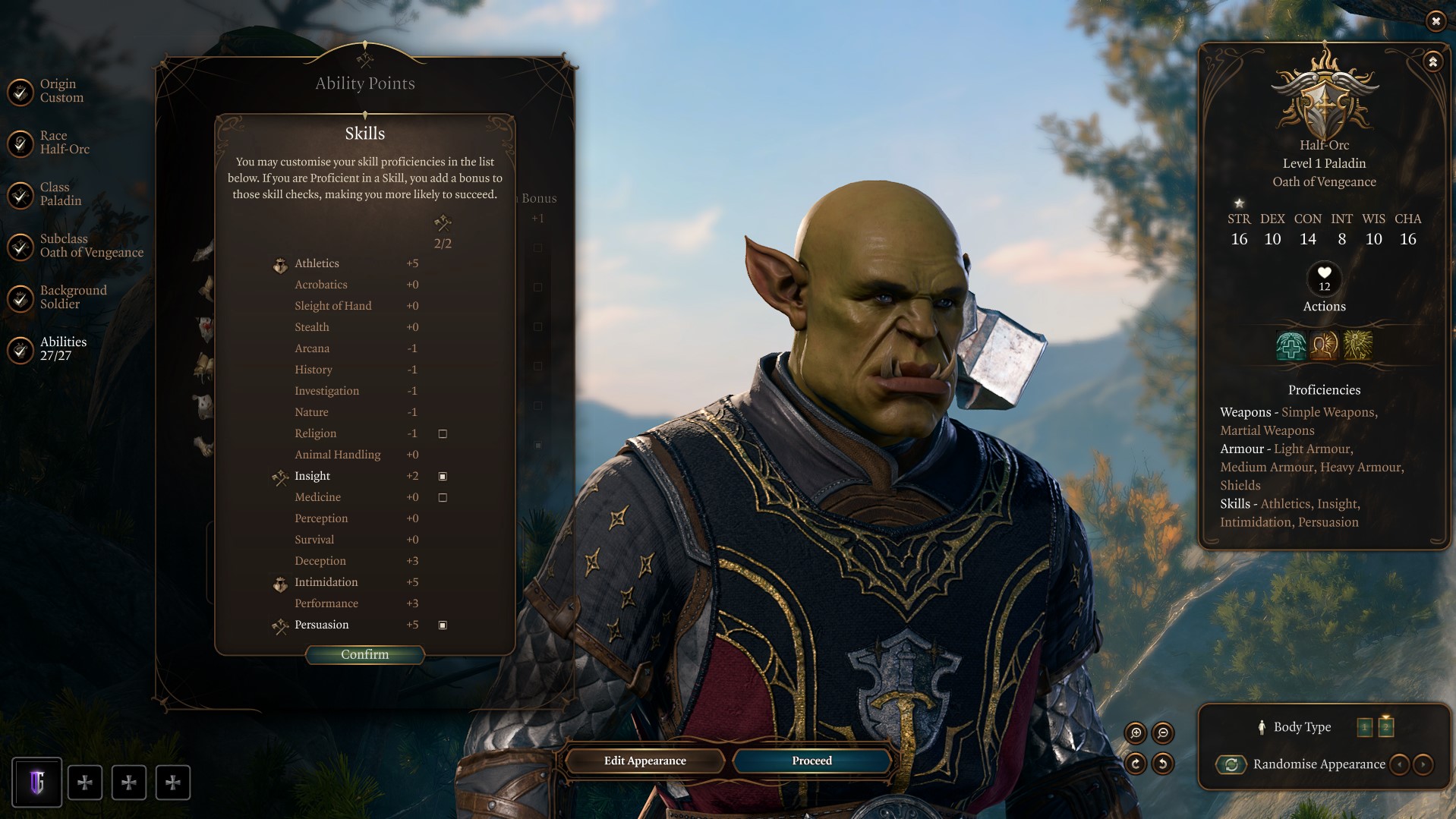
Persuasion and Insight are the best skills for the Paladin Oath of Vengeance in Baldur’s Gate 3 because they complement your class abilities and enhance your effectiveness in various situations. In Baldur’s Gate 3, skills represent the abilities and proficiencies of your character that allow them to perform various actions and interact with the game world. Skills are associated with specific attributes and are used to determine the success or effectiveness of certain actions or abilities. They can be edited during character creation or with companions, during respec or reroll screen.
Here are the best skills for Paladin Oath of Vengeance in Baldur’s Gate 3:
- Persuasion is a Charisma Skill used entirely for dialogue Ability Checks.
- Insight is a Wisdom skill used in dialogue and exploration.
In Baldur’s Gate 3, each skill is related to a specific ability score and its effectiveness scales with the level of that score. You want to choose skills for your character that they already have a high ability score in. For example, if you want to have high Persuasion (which is used to influence dialogue choices), you need to have correspondingly high Charisma. Ideally, you want a party composition that includes a variety of high-ability scores that can give you success in different skills for the Best Baldur’s Gate 3 Paladin Oath of Vengeance Build Guide.
Best Paladin Ability Score
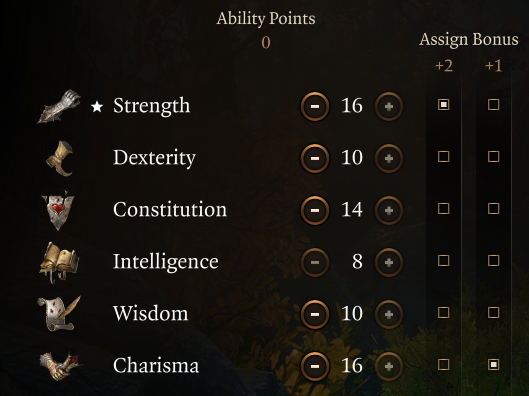
Below is the best ability score to unlock the full potential of a Best Baldur’s Gate 3 Paladin Oath of Vengeance Build:
| Ability | Points Goal |
|---|---|
| Strength | 16 |
| Dexterity | 10 |
| Constitution | 14 |
| Intelligence | 8 |
| Wisdom | 10 |
| Charisma | 16 |
The Best Ability Score for the Paladin is 16 Strength and 16 Charisma for high-damage melee abilities and spells like Divine Smite. The next priority is Constitution to 14 so you have a larger enough health pool to survive. Hitting Strength and Charisma at 16 is critical for the optimal damage setup for the Paladin.
After you choose the class, subclass, race, and background, the game will automatically distribute your abilities in the character creation abilities tab. You will need to reprioritize the stats for the chart for an optimal Paladin build. Simply use the plus-minus in the character creator and make sure you have the suggested race, or the numbers will be off. If you don’t reach these numbers due to racial choice, drop your Wisdom lower for the Best Baldur’s Gate 3 Paladin Oath of Vengeance Build Guide.
Related:
Best Companions for Paladin Oath of Vengeance in Baldur’s Gate 3
Companions for the Best Paladin Build, we recommend range and support characters. The idea is, that your character charges in melee range with support, range damage, or even stealth attacks. If you have multiple melee characters, 2-3, it can be troublesome in close-quarters combat.
- Shadowheart (Cleric): buffs, healing, and crowd control.
- Gale (Wizard): range magic damage, area damage, and crowd control.
- Astarion (Rogue): burst damage, lockpicking, and range if needed.
When putting your party together, consider companions for not only their combat prowess but also their outside abilities and skills that can influence storytelling, dialogue, and exploration. A balanced party will fit the traditional RPG ‘holy trinity’: Tank, Healer, and DPS. Ideally, in Baldur’s Gate 3, you are going to want one tank, one healer, one melee DPS, and one range DPS. Some classes/subclasses can cover both roles, so feel free to experiment and find out what works best for you with the Best Baldur’s Gate 3 Paladin Oath of Vengeance Build Guide.
Paladin Spell Slots
Below is a list and chart that shows the levels and spell slots unlocked for the Paladin class in Baldur’s Gate 3:
| Paladin Level | 1st | 2nd | 3rd |
|---|---|---|---|
| Level 1 | 0 | 0 | 0 |
| Level 2 | 2 | 0 | 0 |
| Level 3 | 3 | 0 | 0 |
| Level 4 | 3 | 0 | 0 |
| Level 5 | 4 | 2 | 0 |
| Level 6 | 4 | 2 | 0 |
| Level 7 | 4 | 3 | 0 |
| Level 8 | 4 | 3 | 0 |
| Level 9 | 4 | 3 | 2 |
| Level 10 | 4 | 3 | 2 |
| Level 11 | 4 | 3 | 3 |
| Level 12 | 4 | 3 | 3 |
Paladin Illithid Powers
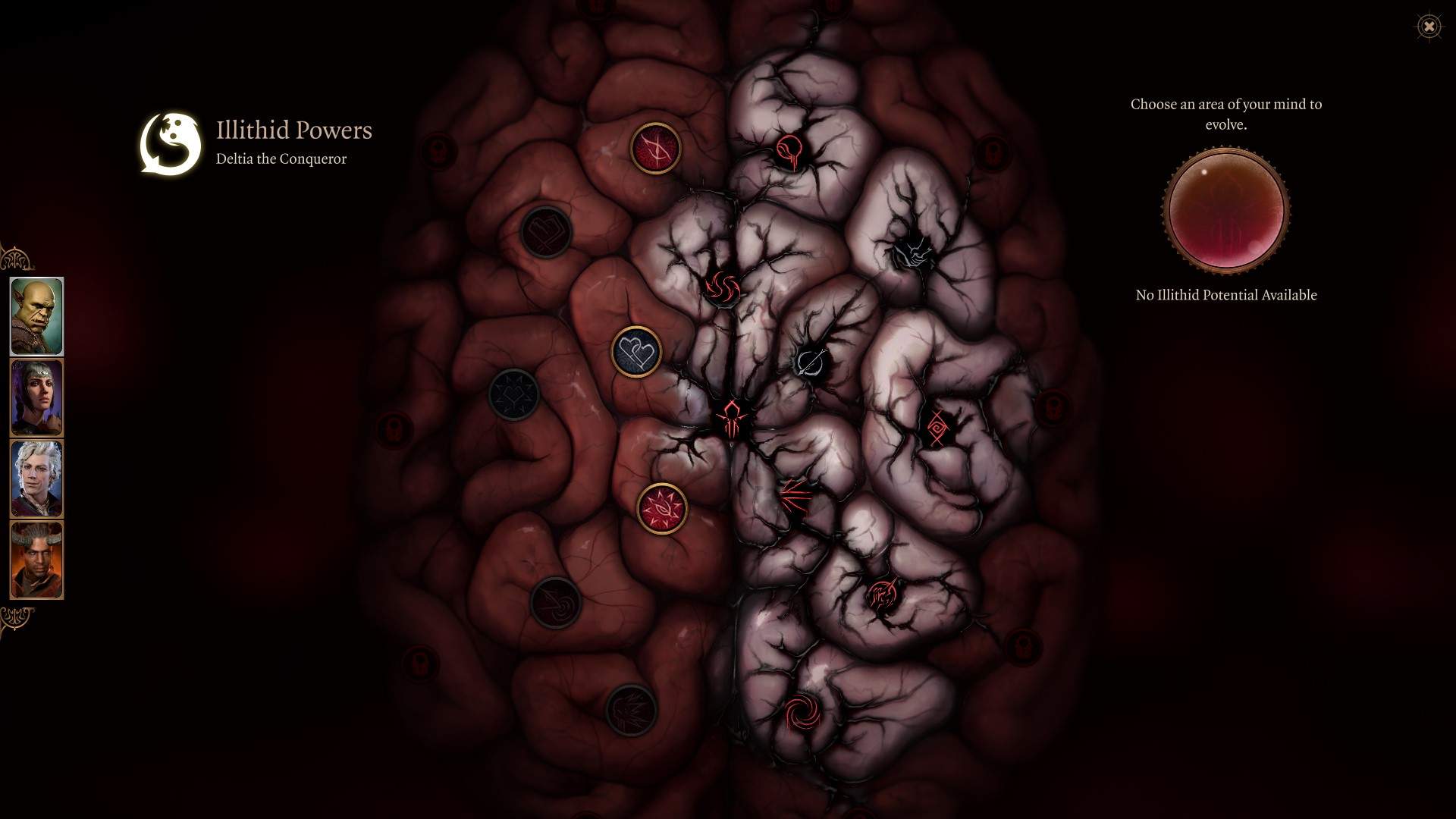
Illithid Powers are unlocked later in the game when you learn more about the Mind Flayers and Tadpoles. You can gain jars of Mind Flayer Parasite Specimens, and consume them to gain one point. This is essentially another skill tree advancement with some very strong powers. If you decide to advance this skill line, these are the choices we suggest.
Here are the best Illithid Powers for the Paladin Build:
| Illithid Powers | Description |
|---|---|
| Luck of the Far Realms | When you make a successful Attack Roll against a foe, you can change that hit into a Critical Hit. |
| Cull of the Weak | When you bring a creature down to fewer hit points than your number of evolved Illithid powers, it dies and all nearby creatures take 1-4 Psychic damage. |
| Psionic Backlash | When an enemy within 9m casts a spell, you can use your reaction to inflict ld4 Psychic damage to the caster per the spell’s level. |
| Blackhole | Area-based suck-in that slows targets. |
| Repulsor | Massive area knockback that can hit friendlies. |
Related:
Paladin Level Progression
| Level | Class | Selection |
|---|---|---|
| 1 | Paladin | Lay on Hands, Divine Sense, Inquisitor’s Might |
| 2 | Paladin | Divine Smite, Great Weapon Fighting, Searing Smite, Thunderous Smite, Shield of Faith, Divine Favor, Cure Wounds |
| 3 | Paladin | Command, Receives Hunter’s Mark, Receives Bane, Vow of Enmity, Abjure Enemy |
| 4 | Paladin | Feat: Ability Improvement Strength, Protection from Evil and Good |
| 5 | Paladin | Extra Attack, Branding Smite |
| 6 | Paladin | Aura of Protection, Magic Weapon |
| 7 | Paladin | Relentless Avenger, Lesser Restoration |
| 8 | Paladin | Feat: Great Weapon Master, Compelled Duel |
| 9 | Paladin | Haste, Protection from Energy, Blinding Smite, Elemental Weapon |
| 10 | Paladin | Aura of Courage, Revivify |
| 11 | Fighter | Defence Fighting Style, Second Wind |
| 12 | Fighter | Action Surge |
Alternative Oath of Vengeance Paladin Build
Investing a couple of levels into the Warlock class first will help you get a much stronger start in Act 1 of Baldur’s Gate 3. This is because the Hexbalde Warlock starts incredibly strong and gets you the Booming Blade cantrip. Then, once you reach level 3, swap to the Paladin and pickup the Vengeance subclass. With five levels of investment, you will have much more movement speed and melee potential. Finish off with the Fighter and Eldritch Knight subclass for even more spellcasting and melee damage potential.
| Level | Class | Selection |
|---|---|---|
| 1 | Warlock | Hexblade, Shield, Hellish Rebuke, Booming Blade, Eldritch Blast |
| 2 | Warlock | Wrathful Smite, Hex spells, One with Shadows, Devil’s Sight Invocations |
| 3 | Paladin | Multiclass Paladin, Vengeance Subclass |
| 4 | Paladin | Great Weapon Fighting, Command, Thunderous Smite, Divine Favour, Shield of Faith, Cure Wounds |
| 5 | Paladin | Protection from Good and Evil |
| 6 | Paladin | Great Weapon Master Feat, Compelled Duel |
| 7 | Paladin | Drop Compelled, select Magic Weapon, Lesser Restoration |
| 8 | Paladin | Aid spell |
| 9 | Fighter | Multiclass Fighter, Defense Fighting Style |
| 10 | Fighter | Action Surge |
| 11 | Fighter | Eldritch Knight subclass, Chromatic Orb, Magic Missile spells, Bursting Sinew, Fire Bolt cantrips, Longstrider extended |
| 12 | Fighter | Savage Attacker feat, Shield spell |
Level 1

At Level one follow our character creator to pick all correct background, race, skills, and ability distribution focusing on Strength and Charisma. You also can pick your subclass, and for this build, we want to select Vengeance. Level two will give you the bulk of your spells, in the early game just rely on weapon damage. Your goal is to find some heavy armor and a two-handed weapon. You can grab medium armor from Lae’zel in the introduction if you don’t plan on using her. Simply attack and at level 2 things start to get interesting with the Best Baldur’s Gate 3 Paladin Oath of Vengeance Build Guide.
Related:
Level 1 Paladin Spell Selections
Here’s a breakdown of what you get as a level 1 Paladin:
- Channeled Oath Charges: Paladin-specific resource that allows the casting of spells and abilities. Used for three oath skills, can be recovered via short rest.
- Lay on Hands: Use your blessed touch to heal a creature or cure it of all diseases and poisons. Single target melee heals using action or cure disease. This consumes Oath Charges but is an effective heal.
- Divine Sense: Gain Advantage on Attack Rolls against celestials, fiends, and undead. This uses a bonus action which can be used with an attack costing an action.
- Inquisitor’s Might: You or an ally’s weapon attacks deal an additional 2 Radiant damage and can Daze enemies for 1 turn. This is a Channeled Oath skill that can add a bit of damage with a chance to stun which is helpful.
- Oath of Vengeance Tenets: No Mercy for the Wicked. This isn’t a mechanic portion, just an oath you need to maintain. If you break the oath, you can unlock a new subclass, Oathbreaker.
At this level move along quickly to level 2 for spell unlocks. Use Lay on Hands for healing, Inquisitor’s Might for extra damage, and swing your sword.
Vengeance Paladin Gameplay & Priorities
During the early phase of BG3, the Vengeance Paladin will have dreadful mobility. Thus, you need to find and locate a back-bar ranged weapon like a Heavy Crossbow from Lae’zel or others. This gives you some type of upfront damage before you can close the distance. However, at level 5, you will unlock Misty Step and dramatically improve your power and mobility. Moreover, look to acquire Elixir of Hill Giant Strength and Oil of Accuracy. You can combine these two for huge damage increases and your Paladin will feel very powerful immediately.
Your overall priority with this build is the following:
- Complete Prologue
- Recruit Companions
- Reached Hollowed City/Druid Grove
- Sell, Stock up, complete quest
- Unlock Withers, respec companions
- Progress to level 5
- Reach Underdark and Grymforged
Following these steps ensures a strong foundation, especially if you plan on playing solo or on Honour Mode difficulty.
Level 2
At level two the Paladin gains access to five prepared spells, choose a fighting style, and Divine Smite. Here is a list of what to do as a level two Vengence Paladin:
Divine Smite: uses spell slot and hits in conjunction with weapon strike. Can be automatically applied, only during critical hits or have a popup box via the reactions menu. Be cautious at first about using this too often. You will burn through your spell slots quickly at this low level, and either have to rest or just use melee attacks only.
Great Weapon Fighting: passive feature when you roll a 1 or 2 on a damage die for an attack with a Two-Handed melee weapon, that die is rerolled once. This minimizes low-damage rolls and keeps your damage high especially using a Two-Handed weapon like a Greatsword.
Level 2 Paladin Spells Selection
- Searing Smite: Your Weapon deals an extra 1d6 Fire damage and marks the target with Searing Smite. A target with Searing Smite takes 1d6 Fire damage every turn until it succeeds on a Constitution saving throw. This is your hard-hitting single-target spell that also gives a damage-over-time fire effect. However, try to avoid its usage because it consumes a bonus action in addition to an action.
- Thunderous Smite: Your weapon rings with thunder as you strike, pushing your target 3m away and possibly knocking it Prone. This attack can act like Crowd Control when you need a stun. You want to use this when needing a stun on a hard-hitting enemy. The best usage is from stealth to initiate combat.
- Shield of Faith: Surround a creature with a shimmering field of magic that increases its Armour Class by 2. This uses a bonus action and requires concentration and should be used before fights where you expect to take the majority of the damage.
- Divine Favor: Your weapon attacks deal an additional 1d4 Radiant Damage. This adds damage to our weapon attacks but consumes a spell slot which can be exhausted early in the game.
- Cure Wounds: Touch a creature to heal it. Typically avoid using this spell unless you cannot use Lay on Hands.
Paladin Gameplay Changes
With all of these spells, it’s important to not use them liberally. Divine Smite can proc (consuming an extra spell slot) and deliver extra damage in combination with basic main-hand weapon attacks or Thunderous Smite. So if you Critical Strike with a weapon attack, you can add additional damage on top merely by consuming a spell slot. Spell slots are the main issue with the Paladin and the need for constant rest. Thus, you need to be very diligent not to expend them all. Spells like Blessed and Shield of Faith seem great but can be used by a Cleric in your group.
In summary, save your spell slots and use them for extra burst damage with a weapon attack/divine smite combo.
Paladin level 2 Prepared Spells: Searing Smite, Thunderous Smite, Shield of Faith, Divine Favour, Cure Wounds.
Level 3

At level 3, the Paladin will select their subclass Vengence. This level also unlocks another level 1 spell slot, Divine Health, and subclass features. Here’s a list of what happens as a level 3 Paladin:
- Gain Divine Health: prevents the disease from affecting you (passive benefit).
- Abjure Enemy: Fight an enemy. They’ll be easier to hit and cannot move. Fiends and undead have Disadvantage on this Saving Throw. Helpful against fiends specifically.
- Vow of Enmity: Gain Advantage on Attack Rolls against an enemy. Niche usage against specific enemies.
- Receives Bane: Up to 3 creatures receive a -1d4 penalty to Attack Rolls and Saving Throws. Not used on this build, waste a spell slot.
- Receives Hunter’s Mark: Mark a creature as your quarry to deal an additional 1d6 Slashing Damage whenever you hit it with a weapon attack. If the target dies before the spell ends, you can mark a new creature without expanding a Spell Slot. Great debuff spell single target and you can reapply after a kill for free with a bonus action.
- Command: Command a creature to flee, move closer, freeze, drop to the ground, or drop their weapon. This is your crowd control ability that can be used at range.
Vengeance Subclass Gameplay
You now have a lot of versatility in spells, skills, and actions. The premise here is to use bonus actions and actions effectively per turn. At this level, I rarely use Thunderous or Searing Smite. It consumes both action and bonus action which is very costly. The first turn, I usually buff with Divine Favour or Shield of Faith, then attack in melee. The following turn, I decide on priority. For a stun, stun, Command is a great option. However, if I just have to kill a target, I’ll use my spell slots for Searing Smite. If we need high damage and a single target stun, Thunderous Smite. Generally, I melee attack and try to use Hunter’s Mark as my bonus action if my concentration spell falls off (Divine Favour or Shield of Faith).
Even at level 3, the Paladin can be complex. Buff turn one, and use burst damage turn two. Turn three and evaluate what your group needs, crowd control, burst, healing, etc. Rinse and repeat that model until later in the game. It will get easier and more effective as you unlock spell slots. Also, check if you have a bonus action spent before ending your turn. If not, Hunter’s Mark, Divine Favour, or Shield of Faith can be vital if you have spell slots.
Paladin level 3 Prepared Spells: Searing Smite, Thunderous Smite, Shield of Faith, Divine Favour, Cure Wounds, Command.
Level 4
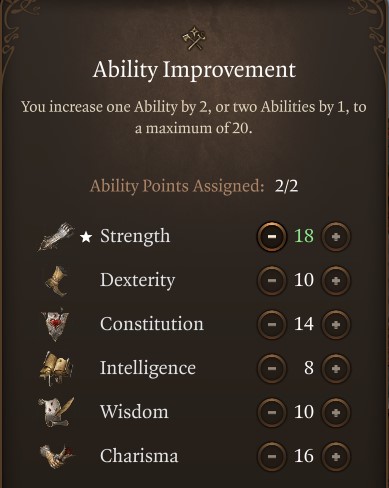
Level four gives you a very important decision between increasing your ability score like Strength or taking a feat. Feats give you a big benefit but doing so will have you miss out on Ability Improvements. Simply increasing your main stat strength to 18 is the simplest and easiest way to advance your character. You can do this by selecting ability improvement rather than +2 to strength.
At level 8 we will take Great Weapon Master and at level 12 (max level in Baldur’s Gate 3) we will take another +2 to strength. This will keep our build simple at the moment, and we will hit hard with a better percentage chance with a melee weapon. You get one additional spell to slot and I recommend Protection from Evil and Good.
Protection from Evil and Good: Protect an ally against the attacks and powers of aberrations, celestials, elementals, fey, fiends, and undead. The target can’t be Charmed, Frightened, or possessed by them, and when these creatures attack it, they do so with a disadvantage. This is a niche spell for this build and is not used often. It comes in handy in particular fights where your character is crowd-controlled on turn one and does nothing but sit there charmed. Otherwise, take another skill you find more appealing and consider this a flex.
Gameplay: remains unchanged at this level. Expect more damage and better chances to land an attack. Keep leveling to get more spells and more spell slots.
Level 4 Paladin Prepared Spells: Searing Smite, Thunderous Smite, Shield of Faith, Divine Favour, Cure Wounds, Command, Protection from Evil and Good.
Level 5

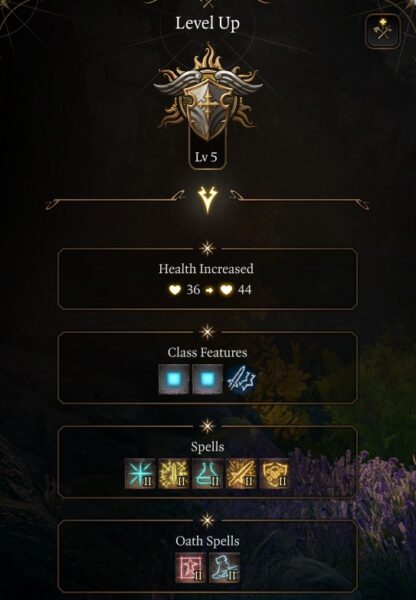
At level 5, the Paladin and Oath of Vengeance subclass unlocks a lot. Extra attack, more spell slots, and two subclass spells. Here’s a list of what to expect as a level 5 Paladin in Baldur’s Gate 3:
Extra Attack: You can attack twice with one action. This combined with Divine Smite and the added spell slots allows you to mega single target damage pure turn.
Branding Smite: deals 2d6 radiant damage and Possibly marks your target with light, preventing it from turning Invisible. Another hard-hitting Smite though I prefer to save spell slots.
Extra Attack
Level 5 unlocks a lot of offensive and defensive potential for the Paladin. Extra Attack gives you two attacks in one with a chance to proc Divine Smite on each. You can also combo this with a Potion of Speed or the Haste spell for two actions per turn. Your bonus action can be used for debuffs, and at level 8, another attack. You have two free spells courtesy of the Vengence subclass. The best is Misty Step. The strength is this spell gives you great mobility and only uses bonus action. Now you can close the gap, charge in, and have amazing mobility alongside huge single-target damage.
At this level and beyond, you should feel very powerful. You can buff and debuff with a bonus action, mobility with Misty Step, and huge damage for the scenario or enemy using Smite. The issue with the build at this point is spell slots and using your big damage Divine Smite reaction appropriately. You will also need to rest constantly. Do not go off wandering into the unknown without your spell slots full.
Level 5 Paladin Prepared Spells: Searing Smite, Thunderous Smite, Shield of Faith, Divine Favour, Cure Wounds, Command, Protection from Evil and Good, Branding Smite.
Level 6
At level 6 the Paladin unlocks 1 more prepared spell bringing the total to 9. You also get Aura of Protection.
Aura of Protection: You and nearby allies gain a bonus to Saving Throws equal to your Charisma modifier. Active this passively for a bonus that stacks on other Auras.
Magic Weapon: Infuse a weapon with arcane energy. The weapon becomes magical, receiving a +1 bonus to Attack and Damage Rolls. This is a decent buff to damage, but it comes at the cost of a high-level spell slot and concentration. Another decent spell to add to our arsenal.
Once you unlock Aura of Protection you need to activate it for its effect. Gameplay not much changes at this level.
Level 6 Paladin Prepared Spells: Searing Smite, Thunderous Smite, Shield of Faith, Divine Favour, Cure Wounds, Command, Protection from Evil and Good, Branding Smite, Magic Weapon.
Ending Act 1 with Vengeance Paladin
At this level, you should be close to transitioning out of Act 1. Make sure to check vendors and stock up on camp and alchemy supplies. Moreover, look over the best Act 1 items. There are also permanent bonuses you can acquire in Act 1. Lastly, Grymforge has powerful armor and weapons (Adamantine) that can aid you well into Act 3. Consider taking the time to collect the Mithral, Mould, and Craft items before transitioning to Act 2, where you won’t be able to return (Moonrise Tower).
Level 7
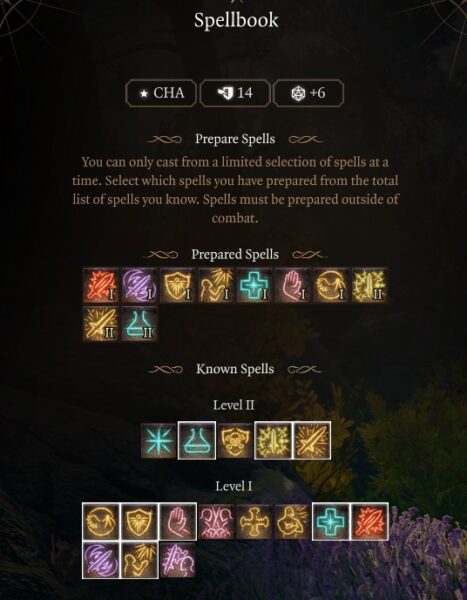
At Level 7, the Paladin Unlocks the following:
- Relentless Avenger: (Subclass Feature)(If you hit an enemy with an Opportunity Attack, your movement speed increases by 4.5m on your next turn.)
- Additional Level 2 spell slot.
Spell
- Lesser Restoration: Cure a creature from disease, poison, paralysis, or blindness.
- Usage: used in rare circumstances, but when an ally is critically paralyzed and you need them to be able to take a turn.
Gameplay: not much changes and we are about to level 8 for a BIG boost in power with one of my favorite feats in the game.
Level 7 Paladin Prepared Spells: Searing Smite, Thunderous Smite, Shield of Faith, Divine Favour, Cure Wounds, Command, Protection from Evil and Good, Branding Smite, Magic Weapon, Lessor Restoration.
Level 8
At level 8 the Paladin gets to pick a Feat or Ability Improvement, we suggest taking Great Weapon Master.
Compelled Duel: Compel an enemy to attack only you. It cannot attack other creatures. Another niche spell that can help you soak damage if other allies are low. Consider this a flex skill.
Great Weapon Master feat which does the following: When a melee attack scores a critical hit or kills a creature, you can make another melee attack as a bonus action. When attacking with Heavy Weapons you are proficient with, attack rolls take a -5 penalty, but their damage increases by 10.
The Great Weapon Master feat does two things for you. One, it has a high-risk high reward ability to add 10 damage BUT -5 attack roll penalty. As shown in the picture above, this simply reduces your percentage chance to hit significantly. You can turn this off in the Passive section on your toolbar, which will give you the normal percentage.
Secondly, this feat gives you another chance to hit on a kill or critical hit using a bonus action. This is the real reason the feat is so strong, multiple attacks in a turn, and with this build, you will be getting a lot of critical hits and kills. Combat should therefore be initiated using your action first, saving your bonus action for a Great Weapons Master attack.
Great Weapon Master Usage
At level 8 you now have the god-tier Great Weapon Master and enough Strength to take advantage of it. Here’s how you want your turn to go after you are buffed:
- Action One Attack (proc Divine Smite) goal kill target or critical strike
- Action Two Attack (proc Divine Smite) goal kill target or critical strike
- Proc Great Weapon Master from kill or critical hit, then use bonus action for another attack (proc Divine Smite).
That is a lot of attacks without using a specific Smite because the bonus action can proc Great Weapon Master. This doesn’t mean you shouldn’t use Branding, Thunderous, or Searing Smite, it’s just now you have options considering your bonus action is so valuable.
You can take this a step further by using a Potion of Speed or have someone cast Haste on you. This will give you an additional action, two more attacks and possibly two more divine strikes. In one turn, if things go well, the Paladin is an absolute force with this setup. Buff with bonus action on the first turn, and use primary melee attacks on the second with the goal of proc Great Weapon Master. Use your Smites and spell slots when you need a big damage attack. Heal rarely, and Misty Step for mobility.
Level 8 Paladin Prepared Spells: Searing Smite, Thunderous Smite, Shield of Faith, Divine Favour, Cure Wounds, Command, Protection from Evil and Good, Branding Smite, Magic Weapon, Lessor Restoration.
Levels 9
The level 9 Oath of the Vengence Paladin unlocks 2 Level 3 Spell Slots and two subclass-specific spells.
Haste (subclass spell): Target yourself or an ally to become Hastened. The creature has a +2 bonus to Armour Class, an Advantage on Dexterity Saving Throws, its Movement Speed is doubled, and can take one additional Action per turn. When the condition ends, the creature becomes Lethargic. This is one of the best spells in the game because it increases actions. The downside of the Paladin using it, it takes action and a much-needed level 3 spell slot. I prefer to use Potion of Speed which gives the same effect for fewer turns.
Protection from Energy (subclass spell): Most of our level 3 spells will be used for Smite or Elemental Weapon, but this can save your life in very specific fights with heavy single-focus elements. Otherwise, consider this a utility skill.
Blinding Smite: +3d8 radiant damage and possibly Blind your target. This spell is your big nuke using Smite along with Blind it makes it a must-have and our primary usage of level 3 spells.
Elemental Weapon: Imbue a weapon with elemental power. It receives a +1 bonus to Attack Rolls and deals an additional 1d4 damage of your choice. Consider this an enhanced Divine Favour adding +1 to attack rolls as well. The downside is it costs an action and a level 3 spell slot. However, if you can pre-buff using this before a fight expect even more damage.
Gameplay at Level 9
At this level, you have even more in your arsenal. Most of the added spells will be used in niche situations. Your bread and butter remains the same, Smite damage. With Blinding Smite you have a hard counter against fellow martial weapon users. Giving the Blind debuff alongside 3d8 radiant damage is massive. Keep things simple and use your off-healing, crowd control, and utility only when needed.
Note on prepared spells, make sure to drop Compelled Duel so you can pick up two level 3 spells.
Level 9 Paladin Prepared Spells: Searing Smite, Thunderous Smite, Shield of Faith, Divine Favour, Cure Wounds, Command, Protection from Evil and Good, Branding Smite, Magic Weapon, Lessor Restoration, Blinding Smite, Elemental Weapon.
Levels 10
The level 10 Paladin unlocks the following in Baldur’s Gate 3:
- Lay on Hands Charge
- Aura of Courage: You and any nearby allies can’t be Frightened. The aura disappears if you fall Unconscious.
- 1 Spell (take Revivify)
- Revivify: Revive a companion. They return to life with 1 hit point.
- Usage: typically you can throw potions or use the help function but this can be useful for long range to bring someone back.
Gameplay remains unchanged at this level with more utility.
The Level 10 Paladin Prepared Spells: Searing Smite, Thunderous Smite, Shield of Faith, Divine Favour, Cure Wounds, Command, Protection from Evil and Good, Branding Smite, Magic Weapon, Lessor Restoration, Blinding Smite, Elemental Weapon, Revive.
Level 11
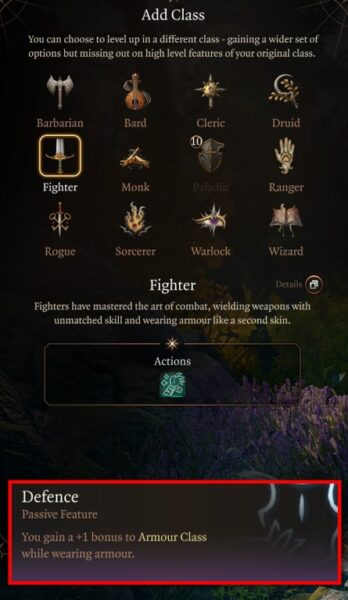
At level 11 the Paladin doesn’t get much beyond an extra spell and another level 3 spell slot. I recommend spending the last two levels multi-classing this class. Investing two levels into Fighter will give you a passive +1 Armour Class (AC) for using armor and a god-tier skill, action surge. If you want to stick with Paladin, you can choose another spell at this level, and at level 12 pick +2 strength feat. However, I suggest taking two levels into Fighter to increase your action potential, which increases your damage significantly.
Having 20 strength with another ability improvement is great. However, you get even more with potions of Hill Giant, 21 and 27 depending on the usage. I typically do not recommend multi-classing, but the Paladin can benefit from another action once per fight.
- Defence Fighting Style: While you are wearing armor, you gain a +1 bonus to AC. This is a passive benefit at level 1 Fighter and will help with survival.
- Second Wind: this skill is unlocked at level one Fighter and is a mediocre heal that is useful during the start of the game. You can use a bonus action, though most potions outperform it.
If you multi-class, this level will feel uneventful, but trust me it’ll be worth it. Prepared Spells remain unchanged from here on out.
Level 12
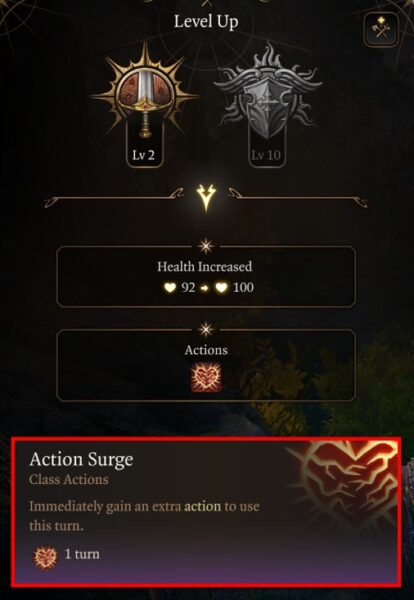
With two levels into Fighter, you get access to the awe-inspiring Action Surge. You get an extra action, but the biggest strength is, it doesn’t require any resources to use it. Action Surge is a once-per-fight usage, but it allows you to cast another spell, attack, dash, etc. It gives you that extra oomph that no other class has.
You take your Paladin with Extra Attack and give it Action Surge for 2x more attacks. You can take this a step further by using either a Potion of Haste or casting Haste on yourself. Then you get another action! If you did the math on that:
- Attack one + extra attack = 2
- Attack two (via Action Surge) + extra attack = 4
- Attack three (via Haste) + extra attack = 6
- Great Weapon Master via critical strike or kill = 7 (if you have a bonus action)
The Paladin at level 12 with this setup has so much firepower it’s remarkable. Again, if you wanted a traditional Paladin for all 12 levels, take ability improvement +2 strength or the Alert feat which helps with going early. We hope you enjoyed this build and check out the gear section for more.
Best Gear for Baldur’s Gate 3 Paladin Oath of Vengeance Build
Beginner: Starting the Game
Here’s the best beginner gear for Paladin Oath of Vengeance Build in Baldur’s Gate 3:
| Gear Slot | Best Gear Item | Effect |
|---|---|---|
| Head | Helmet of Smiting | Smite gives HP |
| Cape | – | |
| Chest | Adamantine Splint Armour | 18 AC |
| Gloves | Gloves of the Growling Underdog | Advantage on Melee |
| Boots | Disintegrating Night Walkers | Free Misty Step |
| Necklace | Moondrop Pendant | No Opportunity Attacks |
| Ring | Crusher’s Ring | Increase Movement |
| Ring | Caustic Band | Poison Damage |
| Weapon 1 Main Hand | Sword of Justice | 2d6 Slashing |
| Weapon 2 Ranged | Titanstring Bow | Add STR modifier |
List of best Vengeance Paladin Equipment in Act 1:
- Helmet of Smiting: Located in Underdark Selûnite Outpost X: 163 Y: -248 (Alternatives Haste Helm, Cap of Wrath, or Grymskull Helm).
- Adamantine Splint Armour: Crafted in Adamantine Forge (Alternatives Chain Mail +1, or Githyanki Half Plate).
- Gloves of the Growling Underdog: Chest behind Razglin’s throne room. (X:295 Y:69) (Alternatives Gloves of Heroism, Gloves of Dexterity, or Gloves of Missile Snaring).
- Disintegrating Night Walkers: Obtained in Gyrmforge as part of Free True Soul Nere questline (Alternatives Boots of Striding, Boots of Genial Striding, or Boots of Speed).
- Moondrop Pendant: Sealed chest inside the Owlbear Nest (Alternatives Amulet of Branding, Amulet of Misty Step, or Amulet of Restoration).
- Crusher’s Ring: Can be looted or stolen from Crusher in the Goblin camp (Alternatives Strange Conduit Ring, or Ring of Absolute Force).
- Caustic Band: Obtained from merchant Derryth Bonecloak in the Myconid Colony (Alternatives Fetish of Callarduran Smoothhands, or The Sparkswall).
- Sword of Justice: Looted from Anders near Karlach (Alternatives Silver Sword of the Astral Plane, or Everburn Blade).
- Titanstring Bow: Brem in Zhentarim Hideout (Alternatives Bow of Banshee, Spellthief, or Giantbreaker).
Advanced: End-Game
The following table presents the best advanced and end-game gear for Paladin Oath of Vengeance Build in Baldur’s Gate 3:
| Gear Slot | Best Gear Item | Effect |
|---|---|---|
| Head | Helm of Balduran | Self-healing |
| Cape | Fleshmelter | Return Damage |
| Chest | Helldusk Armour | 21 AC |
| Gloves | Gauntlets of Hill Giant Strength | 23 Strength |
| Boots | Helldusk Boots | Mobility |
| Necklace | Amulet of Greater Health | 23 Constitution |
| Ring | Killer’s Sweetheart | Auto Critical |
| Ring | Ring Of Regeneration | Self-healing |
| Weapon 1 Main Hand | Balduran’s Giantslayer | Best Greatsword |
| Weapon 2 Ranged | Darkfire Shortbow | Gives Haste |
Below is a list of the best Act 3 Equipment for the Vengeance Paladin Build:
- Helm of Balduran: Obtained in Dragon’s Sanctum (Alternatives Helldusk Helmet, Sarevok’s Horned Helmet, or Mask of Soul Perception).
- Fleshmelter: Found in Chest in House of Healing Morgue (Alternative Cloak of Protection).
- Helldusk Armour: Dropped by Raphael in the House of Hope (Alternatives Armour of Devotion, Armour of Persistence, Bhaalist Armour).
- Gauntlets of Hill Giant Strength: Obtained in Archive of the House of Hope (Alternatives Helldusk Gloves, Legacy of the Masters, or Gloves of Soul Catching).
- Helldusk Boots: In a locked chest, Wyrm’s Rock Fortress X: -32 Y: 219 (Alternative Disintegrating Night Walkers).
- Amulet of Greater Health: Found in the House of Hope in Baldur’s Gate City (Alternative Surgeon’s Subjugation Amulet, or Periapt of Wound Closure).
- Killer’s Sweetheart: Obtained from the Gauntlet of Shar in Act 2 (Alternative Ring of Protection, Risky Ring).
- Ring Of Regeneration: Sold by Rolan at Sorcerous Sundries (Alternative Ring of Free Action, Shifting Corpus Ring).
- Balduran’s Giantslayer: Obtained as a reward for completing the Wyrmway trials (Alternatives Sword of Chaos, or Silver Sword of the Astral Plane).
- Darkfire Shortbow: Sold by trader Damon Act 2 Last Light Inn X: -35 Y: 169 (Alternative Fabricated Arbalest).
Best Paladin Consumables, Potions, and Items
The following list represents the best individual use consumable items that will aid in our Best Baldur’s Gate 3 Paladin Oath of Vengeance Build Guide:
- Elixir of Bloodlust: Once per turn when you kill a foe, you gain HP 5 temporary hit points and an additional action.
- Potion of Speed: Gain extra action, +2 AC, Advantage on Dexterity Saving Throws, and double movement speed.
- Elixir of Hill Giant Strength: Increases Strength ability score to 21 until Long Rest.
- Drow Poison: Weapon poison that adds Constitution Saving Throw or becomes Poisoned and falls Asleep.
- Potion of Flying: Drink to gain a flying speed of 60ft for one hour.
- Elixir of Heroism: Gain 10 temp HP and become Blessed until a long rest.
- Potion of Greater Healing: 4d4 + 4 hit points restored.
- Oil of Accuracy: Coat Weapon. Bonus of +2 in Attack Rolls.
- Elixir of Vigilance: Drink to gain a +5 bonus to Initiative and you can’t be Surprised.
- Elixir of Darkvision: (only non-Darkvision race): Drink to gain the ability to see in the dark up to 12m.
Permanent Bonuses
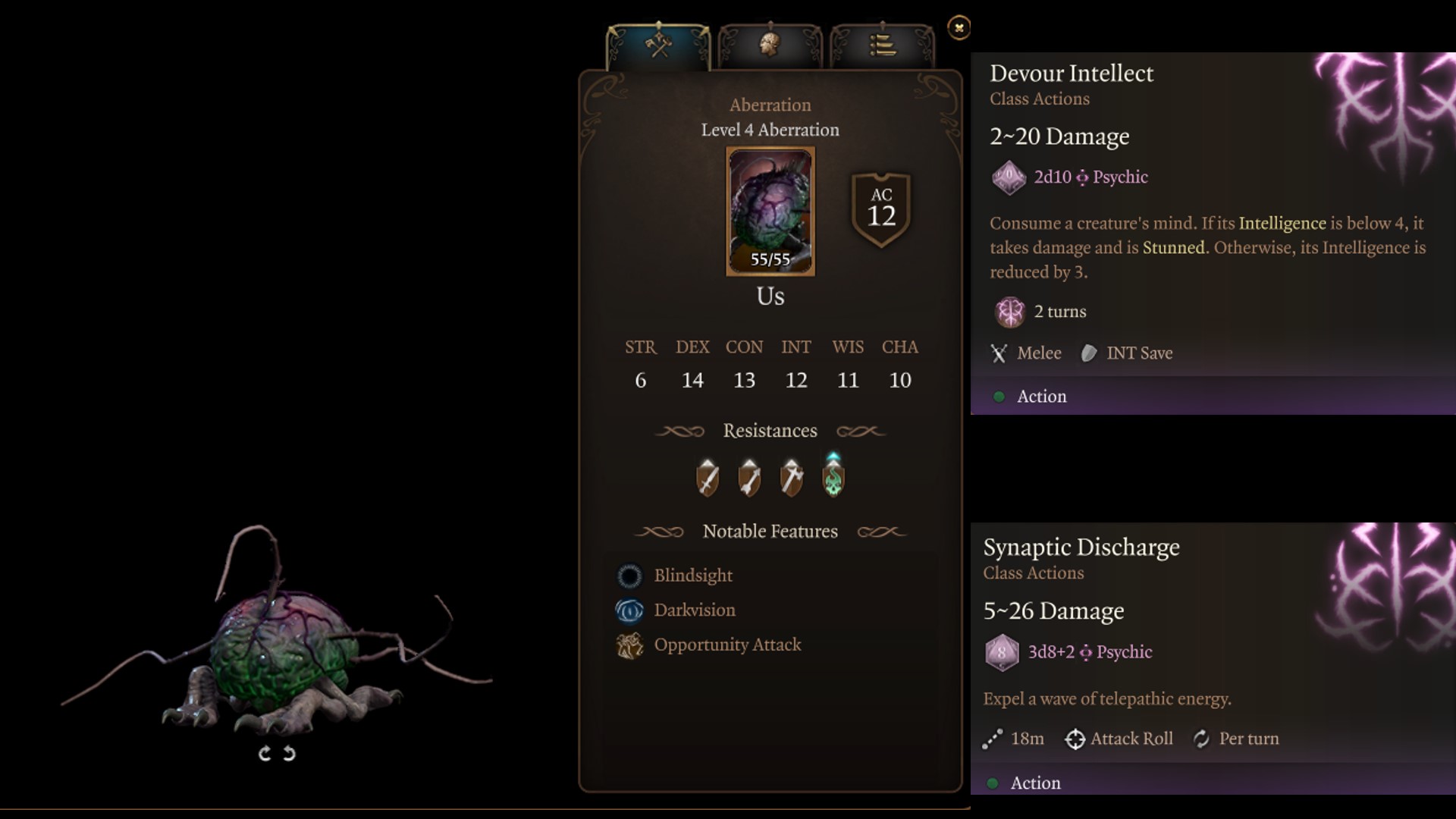
Throughout Baldur’s Gate 3, you will have the ability to gain permanent bonuses to your character. These can grant additional spells, ability scores, and other bonuses. Permanent Bonuses are not displayed throughout the campaign but are vital to increase overall combat performance. We have all permanent bonuses here in a guide, but the most important ones for you to collect are listed below.
| Act 1 | Act 2 | Act 3 |
|---|---|---|
| Auntie Ethel’s Hair: Gain +1 to an Ability Score. | Potion of Everlasting Vigour: Gain +2 Strength. | Mirror of Loss – +2 to an Ability Score of your choice. |
| Awakened: Use illithid powers as a Bonus Action. | Slayer Form: Ability to transform into the Slayer. | Partial Ceremorphosis: Access to tier 3 illithid Powers. |
| Scratch: Gain Find Familiar Scratch. | Summon Us: Allows you to summon Us. | Sweet Stone Features: Blessed permanent. |
| Cheeky Quasit: Gain Summon Quasit Shovel. | Statue of the Gods: +2 to Saving Throws | |
| Loviatar’s Love: 30% Hit Points or less, you gain a +2 bonus to Attack Rolls and Wisdom saving throws. | ||
| Necromancy Of Thay: access to powerful spells in Act 3. | ||
| Volo’s Ersatz Eye: See Invisibility |
Best Permanent Bonuses for Oath of Vengeance Paladin in Baldur’s Gate 3
Paladin Combat, Gameplay, and Tips
The Best Baldur’s Gate 3 Paladin Oath of Vengeance Build Guide uses the best combination of melee, single target damage, healing, and crowd control to survive and fight. You will need to initiate combat, use consumables to replenish health and rely on companions for what your classes don’t have available.
Here are 10 gameplay tips specifically for playing the Best Baldur’s Gate 3 Paladin Oath of Vengeance Build Guide:
- Spell Slots: use your spell slots wisely, especially for Divine Smite and Healing
- Divine Smite: use this extra damage source on the hardest to defeat enemies and save your spell slots for when you really need it.
- Healing: use potions that consume bonus actions or Lay on Hands for yourself or an ally.
- Heavy Armor: find and equip this early for needed AC.
- Crowd Control: make sure to CC enemies with Thunderous Smite or a Companion ability to limit damage.
- Pre-Buff: have a companion cast blessed prior to combat to get a roll Advantage.
- Range: don’t forget to equip a ranged weapon to ensure you can do damage on nearly every turn.
- Long Rest: use the rest at camp function to regain spell slots and don’t go into a fight with zero.
- Great Weapon Master: focus on low-health targets with your first action to strike a kill and another attack with Great Weapon Master.
- Toggle Reactions: make sure both Divine Smite and Great Weapon Master are toggled on or off when you need them.
Changes in Patch 7 for BG3
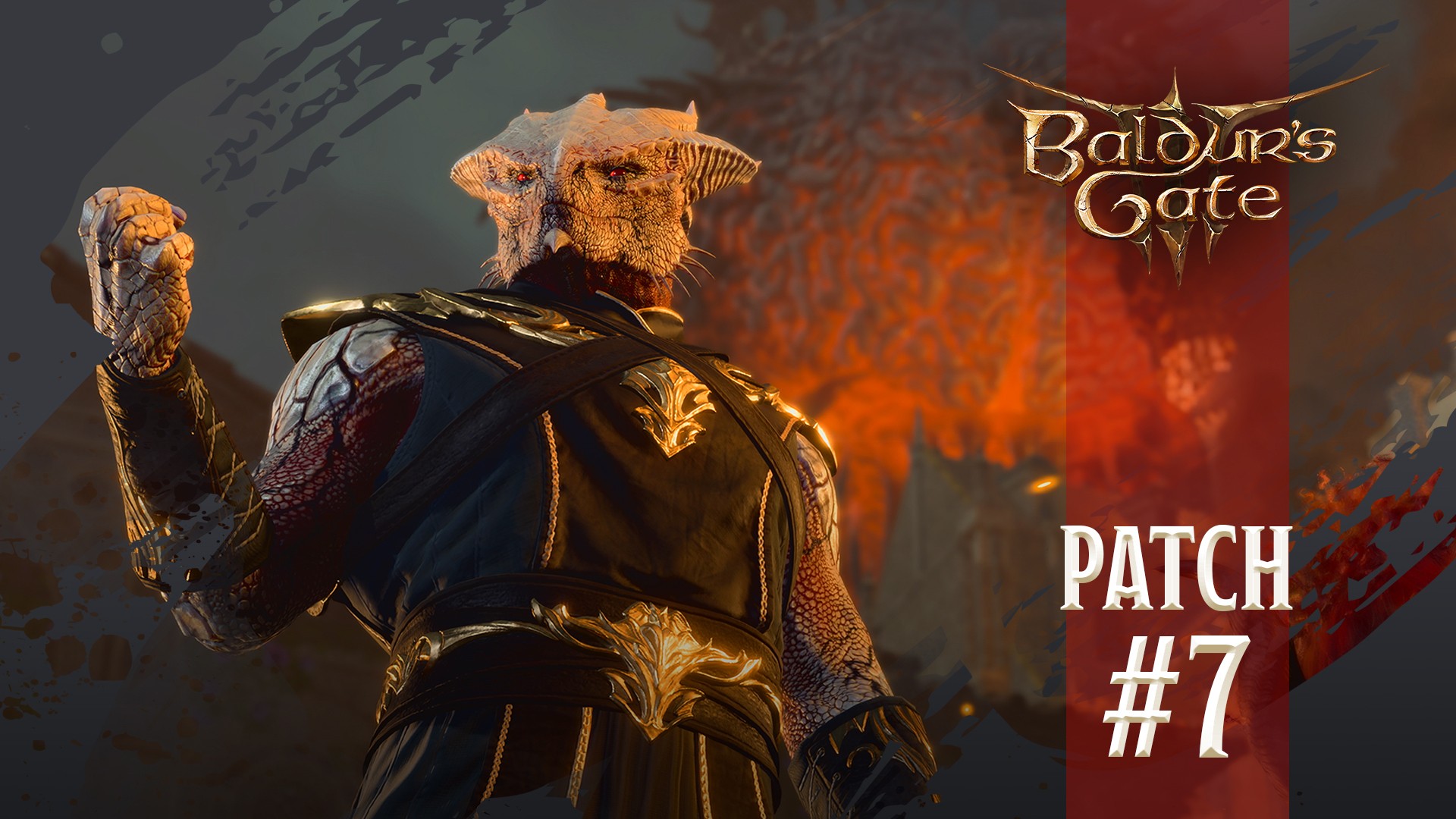
Expect Patch 7 to have little influence on this Palaind build regarding combat; however, many new features were added. Released Patch 7 for Baldur’s Gate 3 on September 5th, 2024, with a massive update to BG3. The developers added 13 new cinematics, including some new fight scenes with the Netherbrain. Additionally, the game will see additional weeks to Honour Mode, adding more legendary actions to current bosses. However, the main focus of this patch for Larian Studio is mods. The game will now feature a modding toolkit and in-game mod manager. This is meant to be a handoff to the community for future players to create unique content to continue the story.
From a Paladin gameplay and combat perspective, little changes in Patch 7. You can expect cool new evil endings, though if you are playing Vengeance, you shouldn’t be using! Honour Mode will be more difficult with more legendary actions but little changes to skills and gear outside of bug fixes.
Baldur’s Gate 3 Paladin Oath of Vengeance Build Summary Guide
Subclass Vengeance
Armor: Heavy
Weapons: Greatsword
Background – Soldier
- Strength: 16
- Dexterity: 10
- Constitution: 14
- Intelligence: 8
- Wisdom: 10
- Charisma: 16
Level Progression
- Level 1 – Inquisitor’s Might
- Level 2 – Searing Smite
- Level 3 – Command
- Level 4 – Feat +2 Strength
- Level 5 – Branding Smite
- Level 6 – Magic Weapon
- Level 7 – Lesser Restoration
- Level 8 – Great Weapon Master
- Level 9 – Blinding Smite
- Level 10 – Aura of Courage
- Level 11 – Multiclass Fighter
- Level 12 – Action Surge
FAQs
Q1. What is the best party combination in BG3?
Best party combination to try out in Baldur’s Gate 3 can be Paladin and Sorcerer.
Q2. Does party comp matter in BG3?
Yes, party composition matters significantly, especially on higher difficulties such as Tactician or Honour Mode.
Q3. What is the best character combination in BG3?
It depends whether you are playing solo or in a party. For a four-player party, Paladin and Sorcerer can be a good pick.
Looking For More About Baldur’s Gate 3?
Thank you for reading Best Baldur’s Gate 3 Paladin Oath of Vengeance Build Guide. We provide the latest news and create guides for Baldur’s Gate 3. Also, watch me play games on Twitch or visit my YouTube channel!
 Reddit
Reddit
 Email
Email
